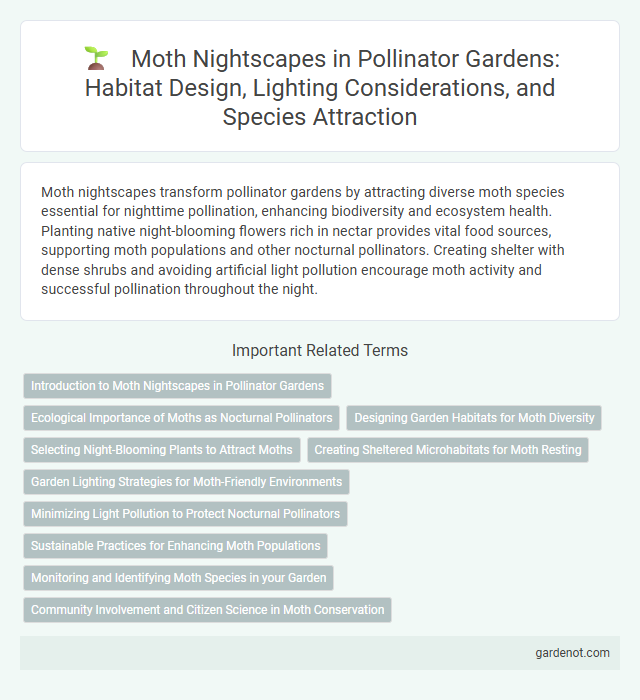Moth nightscapes transform pollinator gardens by attracting diverse moth species essential for nighttime pollination, enhancing biodiversity and ecosystem health. Planting native night-blooming flowers rich in nectar provides vital food sources, supporting moth populations and other nocturnal pollinators. Creating shelter with dense shrubs and avoiding artificial light pollution encourage moth activity and successful pollination throughout the night.
Introduction to Moth Nightscapes in Pollinator Gardens
Moth nightscapes in pollinator gardens create a vital habitat that supports nocturnal pollinators essential for biodiversity and ecosystem health. These gardens feature night-blooming plants such as evening primrose and moonflower, which provide nectar sources attracting diverse moth species. Incorporating moth-friendly lighting and native flora enhances pollination efficiency and sustains moth populations within urban and rural environments.
Ecological Importance of Moths as Nocturnal Pollinators
Moths serve as crucial nocturnal pollinators, supporting the reproduction of numerous night-blooming plants in pollinator gardens. Their activity enhances biodiversity by facilitating cross-pollination, which maintains genetic diversity in ecosystems. Preserving moth habitats strengthens nocturnal pollination networks, crucial for sustaining resilient and productive natural environments.
Designing Garden Habitats for Moth Diversity
Designing garden habitats for moth diversity involves incorporating a variety of native night-blooming flowers and host plants that cater to different moth species' life cycles. Providing shelter through dense foliage and undisturbed leaf litter supports moth larval development and adult resting sites. Creating a pesticide-free environment with diverse plant structures enhances pollination efficiencies and sustains nocturnal moth populations critical for ecosystem balance.
Selecting Night-Blooming Plants to Attract Moths
Choose night-blooming plants such as evening primrose, nicotiana, and moonflower to create an inviting moth nightscape. These plants release strong fragrances and pale-colored blooms that enhance visibility and scent detection for nocturnal pollinators. Incorporating species like jasmine and four o'clock flowers attracts diverse moth populations, supporting biodiversity in a pollinator garden.
Creating Sheltered Microhabitats for Moth Resting
Creating sheltered microhabitats in a pollinator garden enhances moth resting by providing protection from predators and harsh weather conditions. Planting dense shrubs and arranging tall grasses around flowering plants offers safe, secluded spots for moths to hide during daylight hours. Incorporating logs, rocks, and leaf litter further enriches these microhabitats, supporting moth biodiversity and nocturnal pollination activity.
Garden Lighting Strategies for Moth-Friendly Environments
Moth nightscapes require garden lighting strategies that minimize light pollution and use warm, amber-toned LEDs to preserve nocturnal pollinator activity. Implementing shielded fixtures and directional lighting reduces disruption to moth navigation and behavior, fostering a healthier pollinator garden ecosystem. Strategic placement of lights away from key floral resources enhances moth attraction and supports biodiversity in night-time gardens.
Minimizing Light Pollution to Protect Nocturnal Pollinators
Minimizing light pollution in moth nightscapes is crucial for protecting nocturnal pollinators such as moths and bats, whose navigation and feeding behaviors rely on natural darkness. Using low-intensity, amber or red LED lighting and shielding outdoor fixtures helps reduce artificial light spill, preserving natural night conditions. Implementing these strategies supports the biodiversity and ecological function of pollinator gardens by enhancing nighttime pollination efficiency.
Sustainable Practices for Enhancing Moth Populations
Implementing sustainable practices such as planting native night-blooming flowers supports local moth populations by providing essential nectar sources. Minimizing artificial light pollution helps preserve moths' natural behaviors and breeding cycles, contributing to ecosystem balance. Integrating organic pest control methods within the pollinator garden prevents harmful chemical exposure, promoting moth survival and biodiversity.
Monitoring and Identifying Moth Species in your Garden
Monitoring and identifying moth species in your pollinator garden involves using light traps and sugar baits to attract diverse moths during nighttime hours. Documenting moths through photography and field guides enhances species identification, contributing to local biodiversity records. Regular nightscape observations support ecological balance by promoting awareness of nocturnal pollinator activity.
Community Involvement and Citizen Science in Moth Conservation
Moth nightscape events engage communities by inviting citizen scientists to document and monitor local moth populations, contributing valuable data to conservation projects. These participatory initiatives foster environmental awareness and empower residents to play an active role in preserving nocturnal pollinators. Collaborative data collection enhances understanding of moth diversity, distribution, and habitat requirements critical for effective moth conservation strategies.
Moth nightscape Infographic

 gardenot.com
gardenot.com